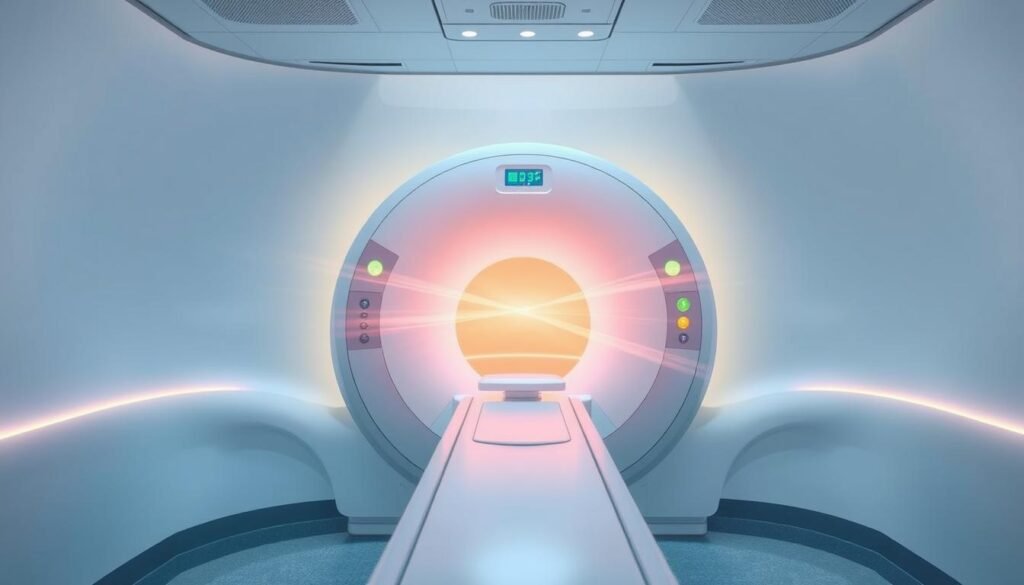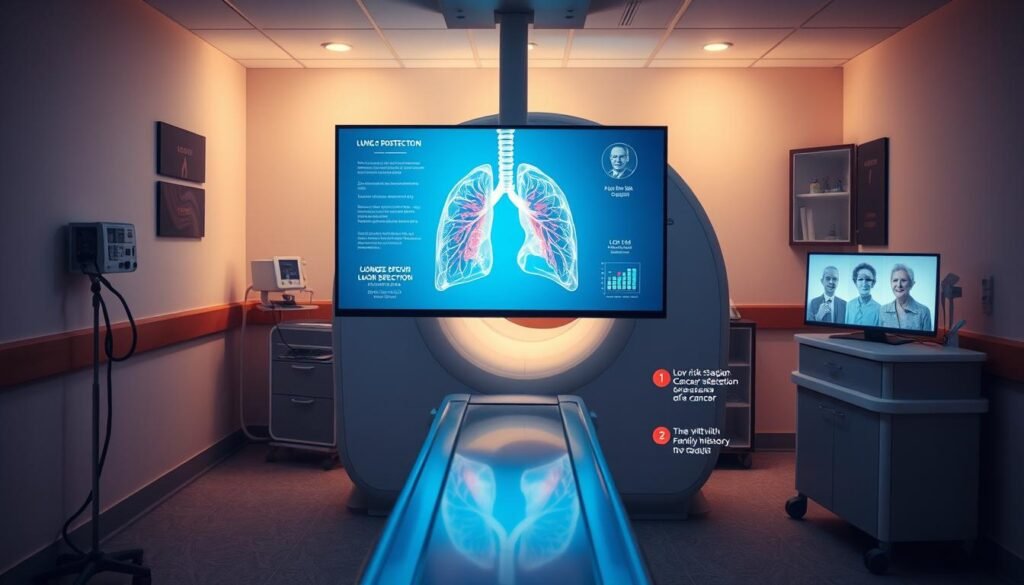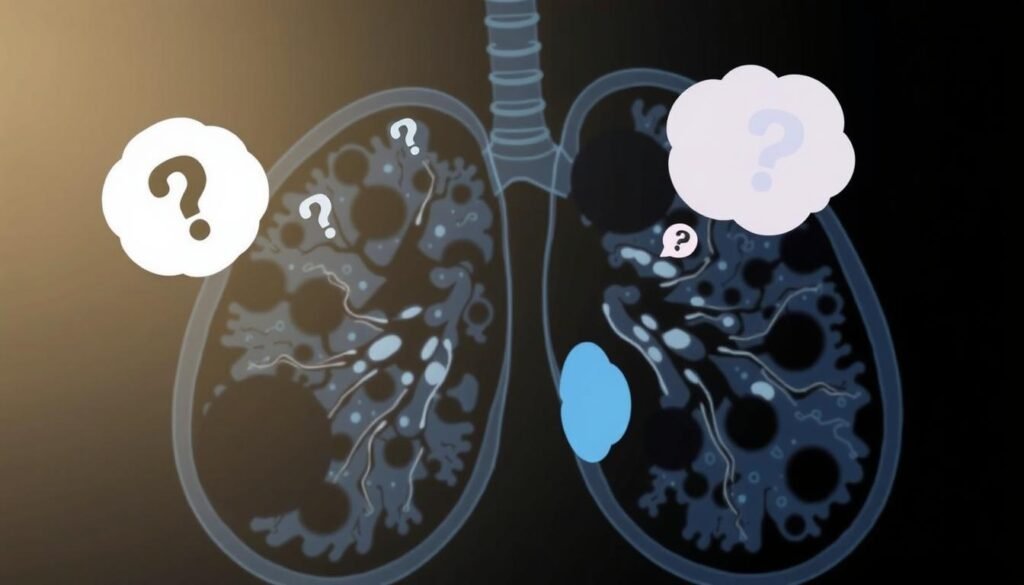Lung cancer is the second most common cancer and the top cause of cancer deaths in the U.S. Yet, only 5.8% of Americans who could benefit have chosen low-dose CT screenings for early detection. These scans have a big impact on survival rates. For instance, the National Lung Screening Trial saw a 20% drop in lung cancer deaths among those screened. This guide explores the importance of these screenings and how they help catch cancer early, improving chances of survival.
The American Cancer Society advises yearly low-dose CT scans for people 50 to 80 years old who smoked heavily in the past. Knowing about this and how to quit smoking can save lives. This guide details the benefits of low-dose CT scans, who should get them, and why they’re crucial for early detection. It’s here to help more people understand and take the steps needed to fight lung cancer.
Key Takeaways
- Low-dose CT scans considerably lower lung cancer mortality rates.
- Annual screening is recommended for individuals aged 50 to 80 with a significant smoking history.
- The majority of lung cancers are diagnosed at a late stage, emphasizing the need for increased screenings.
- Continued support for smoking cessation is crucial for those undergoing lung cancer screening.
- A small amount of radiation exposure is involved, which is more than a chest X-ray but less than a standard CT scan.
Introduction to Lung Cancer Screening
Lung cancer screening is key to finding the disease early, often before symptoms show up. This early detection can lead to more effective treatment and better results for the patient. The main way doctors screen for lung cancer is with a low-dose computed tomography (LDCT). This test looks for small growths or other problems in the lungs. The CDC, along with the American Cancer Society and the US Preventive Services Task Force, suggests screening for those at high risk. This includes people between 50 and 80 years old who have smoked a lot over the years.
Even people who have stopped smoking in the last 15 years should think about getting screened. Other risk factors include having had lung cancer before, chronic obstructive pulmonary disease (COPD), being exposed to asbestos, or having a family history of lung cancer. Research shows that screening can lead to fewer deaths from lung cancer because it catches the disease early. Besides finding lung cancer, low-dose CT scans can also spot other health issues linked to long-term smoking.
Screening for lung cancer is a vital step in battling this serious disease. It’s important for people to understand the risks, who should get screened, and how the screening works. This knowledge lets them make smart choices about their health. As more research is done, the role of screening in a broad health strategy becomes clearer. It helps shape future advice and actions for preventing lung cancer.
The Importance of Early Detection
Finding lung cancer early is key to better survival rates and more treatment choices. When found early, the five-year survival rate can jump to 63%. But, if caught late, the chances drop sharply. In 2020, lung cancer took over 135,000 lives in the U.S., making fast detection crucial.
Statistics on Lung Cancer Survival Rates
Lung cancer is the top killer among cancers worldwide. It claims more lives than breast, prostate, and pancreatic cancers all together. Yet, not everyone who can get screened does so. While 80% of eligible women get breast cancer screenings, fewer people get screened for lung cancer. Projects like the Eddy mobile screening van are helping. They aim to increase screening in areas that don’t have easy access.
How Early Detection Improves Outcomes
Early detection through low-dose CT scans can cut lung cancer death risk by 20-25%. This compares to older methods like chest X-rays. Finding cancer early means more choices for treatment. This greatly improves the chances of beating the disease. People found early have a much better prognosis. To learn more, visit this study on early detection and screening.
What is Low-Dose CT Scanning?
Low-Dose CT scanning is key for spotting lung cancer early. It uses advanced tech to capture clear lung images while cutting down on radiation. This modern method stands out from older scanning ways. It is specially recommended for those at high risk of lung cancer.
Technology Behind Low-Dose CT Scans
The tech used in low-dose CT is amazing at showing lung issues clearly. It exposes patients to much less radiation than normal CT scans, about 90% less. This makes it a safer choice for people needing regular checks. The scan is also quick, finished in about 10 minutes.
Comparison with Traditional Scanning Methods
Comparing low-dose CT scanning to older methods shows its strengths. Old-fashioned chest X-rays often overlook small lung tumors or changes. But, low-dose CT scans are much better at finding lung cancer early. They significantly up the chances of catching the disease sooner. A big study showed these scans could lower lung cancer deaths by 20%.
This information shows how vital they are for better patient survival rates. For more info, this resource dives deep into low-dose CT scans for lung cancer diagnosis.
Benefits of Low-Dose CT Scans
Low-dose CT scans are great for catching lung cancer early. They use new tech to cut down on radiation. This is important to keep patients safe. People get the scans they need with less radiation.
Reducing Radiation Exposure
Low-dose CT scans cut radiation by a lot, about 90% less than old scans. This is a big deal for people who need many tests. It lowers the risk that comes with lots of X-rays.
Enhanced Sensitivity in Cancer Detection
Low-dose CT scans also find cancer better, spotting tiny bad spots sooner. Finding cancer early can mean a better chance to beat it. In fact, catching it early can lead to a 52% survival rate after five years. This is key to fighting lung cancer well.

How Low-Dose CT Scans Detect Lung Cancer Early
Low-dose CT (LDCT) scans are a big step forward in lung cancer screening. They help find lung cancer early. These scans can spot small, non-calcified nodules (NCNs) that might be cancer. A key study showed LDCT screening found NCNs in almost 25% of people. This led to the diagnosis of lung cancer in several cases. It proves LDCT scans are great at catching lung cancer early.
LDCT technology gives clear images of lung structures. This lets doctors carefully check for any signs of cancer. People with nodules get close follow-up. This includes more tests to see if the nodules are cancerous. Catching cancer early means it can be treated sooner. The main aim of using LDCT for lung cancer screening is to act early. This way, the cancer doesn’t get a chance to spread too much.
Studies show that LDCT scans can really help improve treatment success. One national study found they could lower the risk of dying from lung cancer by 20%. Plus, LDCT scans use a lot less radiation than regular CT scans. This means they are safer but still very good at finding cancer.
In conclusion, low-dose CT scans play a key role in checking for lung cancer. They make it possible to spot cancer sooner. This leads to better treatment plans, helping patients live longer, better lives.
Who Should Consider Lung Cancer Screening?
Lung cancer screening is key in catching the disease early. This is especially true for people at high risk. Since lung cancer leads to many deaths in the U.S., knowing who should get screened is vital. It helps save lives.
Criteria for High-Risk Populations
The USPSTF gives clear criteria for those at high risk for lung cancer. These include age and how much someone has smoked:
- Adults aged 50 to 80 years
- At least a 20 pack-years smoking history. That’s like smoking one pack a day for 20 years.
- People who are smoking now or those who quit in the last 15 years
- Checking each person’s health and how long they might live
These points show why early screening is crucial for treating lung cancer successfully.
Recommendations by Health Organizations
Top health groups, like the American Cancer Society and the USPSTF, have guidance on lung cancer screening. They suggest yearly low-dose CT scans to find the disease early in those who qualify. Stopping smoking is also emphasized. They strongly advise:
- Yearly screenings for adults who meet these criteria
- Adding advice on quitting smoking to screening programs
- Thinking about if screening is right for people who stopped smoking more than 15 years ago

The Role of Smoking in Lung Cancer Risk
It’s key to understand how smoking and lung cancer are linked. Smoking is the number one cause of lung cancer, causing about 90% of all cases. It’s crucial to pick out smoking risks to help with screening and protect those at high risk.
The 20 Pack-Year Smoking History Explained
The 20 pack-year mark is a key measure for checking who should get lung cancer screening. It’s like smoking a pack a day for 20 years or two packs a day for 10 years. Those who’ve smoked for 30 or more pack-years are at a far higher risk.
Data revealed 19.03% of studied people had a 30 pack-year history. This increased their chance of detecting lung cancer compared to those who never smoked.
Supporting Smoking Cessation Efforts
Helping people quit smoking is vital for lowering lung cancer risks and boosting public health. Health groups push for full-on quit-smoking programs. These programs include counseling and support for those looking to quit.
Studies show these efforts work well, even for people getting low-dose CT screens and those not screened. Both groups had similar rates of quitting. This shows ongoing support is key in the journey to quit.
| Smoking History Category | Number of Subjects | Lung Cancer Diagnoses | Percentage of Lung Cancer Patients |
|---|---|---|---|
| Never-Smokers | 6,021 | 66 | 49.6% |
| Smokers with | 3,785 | 31 | 23.3% |
| Smokers with ≥30 Pack-Years | 2,305 | 36 | 27.1% |
Targeting smoking through public health efforts is key to cancer prevention. By fighting the smoking issue, health workers aim to cut down on lung cancer deaths and sickness.
Understanding False Positives in Screening
Lung cancer screenings, like low-dose CT scans, sometimes find false positives. Knowing about false positives is key for anyone getting screened. It eases worries about lung cancer screening.
What Are False Positives?
False positives happen when a test wrongly shows lung cancer. Initial screenings see 12% to 14% false positives. This shows why doctors and patients must talk clearly. Although low-dose CT scans boost early detection, false positives are a big worry. Yet, with yearly screenings, false positive rates drop to about 6%. This means tests get more accurate over time.
Managing Anxiety and Follow-Up Procedures
Anxiety with lung cancer screening is normal, especially with false positives. Patients need info on what comes next after a false positive. Handling these cases well means giving hope and next step advice. Follow-up might include more scans or tests, based on the situation. It’s vital for patients to share their worries with doctors and learn how to tackle unexpected scan findings.

Nodule Evaluation and Management
Screening can find lung nodules. After that, it’s key to evaluate and manage them well. This might mean more scans or biopsies. These steps depend on what the nodule looks like and the patient’s risk factors. With the right assessment, doctors can step in early. This helps get better results for the patient.
What to Expect After a Nodule is Detected
Once a lung nodule is found, more tests usually follow. These can include:
- More imaging at set times to watch for changes in the nodule
- Biopsies to check for cancer if the nodule might be serious
- Talking about the risks based on the nodule’s size, shape, and the patient’s medical history
In some cases, small nodules under 6 mm might not need lots of testing. But if they’re bigger, doctors keep a closer eye on them.
Importance of Lung-RADS Classification
The Lung-RADS system is very important for looking at nodules. It helps doctors figure out how to handle them. This system puts nodules in different groups based on how they look. This tells doctors how likely it is the nodule could be cancer. For example:
| Lung-RADS Category | Description | Management Recommendations |
|---|---|---|
| 1 | Negative find; no nodules detected | No follow-up required |
| 2 | BENIGN; stable nodules | No follow-up required |
| 3 | Probably benign; nodules between 4-6 mm | Follow-up in 6 months |
| 4A | Suspicious; nodules greater than 6 mm | Follow-up CT in 3 months |
| 4B | Slightly suspicious; requires further evaluation | Consider biopsy or PET scan |
| 5 | Highly suspicious; likely malignant | Refer for biopsy |
Lung-RADS helps with the early steps in taking care of lung cancer. It guides the treatment plans. And it can change the outcome for patients with lung cancer.
Guidelines for Lung Cancer Screening
Lung cancer screening guidelines have made big advances. They now target people at high risk for the disease. Adults aged 50 to 80 who’ve smoked 20 pack-years or more should get yearly low-dose CT scans, says the U.S. Preventive Services Task Force (USPSTF). This new advice could nearly double eligible individuals for screening. It promises earlier disease detection and better survival chances.
Annual Screening Recommendations
Yearly lung cancer checks are key because they’re proven to lower death rates from the disease. The USPSTF also pushes for doctors and patients to talk openly. This is to weigh the screening’s pros and cons. Both current smokers and those who quit in the last 15 years should seriously consider getting screened.
Implementing Screening in Healthcare Settings
To adopt lung cancer screening well, healthcare needs a plan. Make sure at-risk groups can access screening. It’s crucial they do, to catch the disease early. Healthcare workers must teach patients why screening is important. They should also share resources to help quit smoking. Quitting lowers future lung cancer risk a lot.
Potential Risks and Limitations of Screening
Low-dose CT scans help find lung cancer early. But, they come with risks. One major issue is the high rate of false positives. In the National Lung Screening Trial, about one-fourth of people got false-positive results across three screenings. This leads to unnecessary tests and worry.
There are limits to detecting lung cancer through screening. Even with a reduced death risk shown by a Relative Risk rate of 0.80, overdiagnosis is still possible. In fact, only about 1% of those with positive results actually have lung cancer. This raises doubts about the effectiveness of further tests.
Invasive tests for lung cancer screening can cause complications. Real-world settings saw higher complication rates than clinical trials. Complications can be minor or major, costing up to $56,845. This highlights the importance of discussing lung cancer screening’s risks and benefits.
Knowing the risks and limitations helps people make smart decisions about their health. It’s important to be aware when choosing early detection strategies.
Conclusion
Low-dose CT scans are crucial in improving lung cancer awareness and early detection. Lung cancer takes more lives than many other cancers combined. Identifying it early is key. Patients found with stage 1A lung cancer have a survival rate over 75%. But, this drops to less than 5% at stage 4. Using low-dose CT scans for those at high risk can lead to better survival rates and lower deaths.
Studies like the US National Lung Screening Trial show a 20% drop in deaths from lung cancer with regular screenings. These programs help spot early signs of cancer. They play a big role in preventing the disease. Early screening means those at risk can have a longer life. This shows how important proactive health steps are.
As more support for lung cancer screening grows, our goal is clear. We want to lessen lung cancer’s impact through education and timely interventions. Teaching people about low-dose CT scans helps in this fight. It’s a step towards a future with less lung cancer.